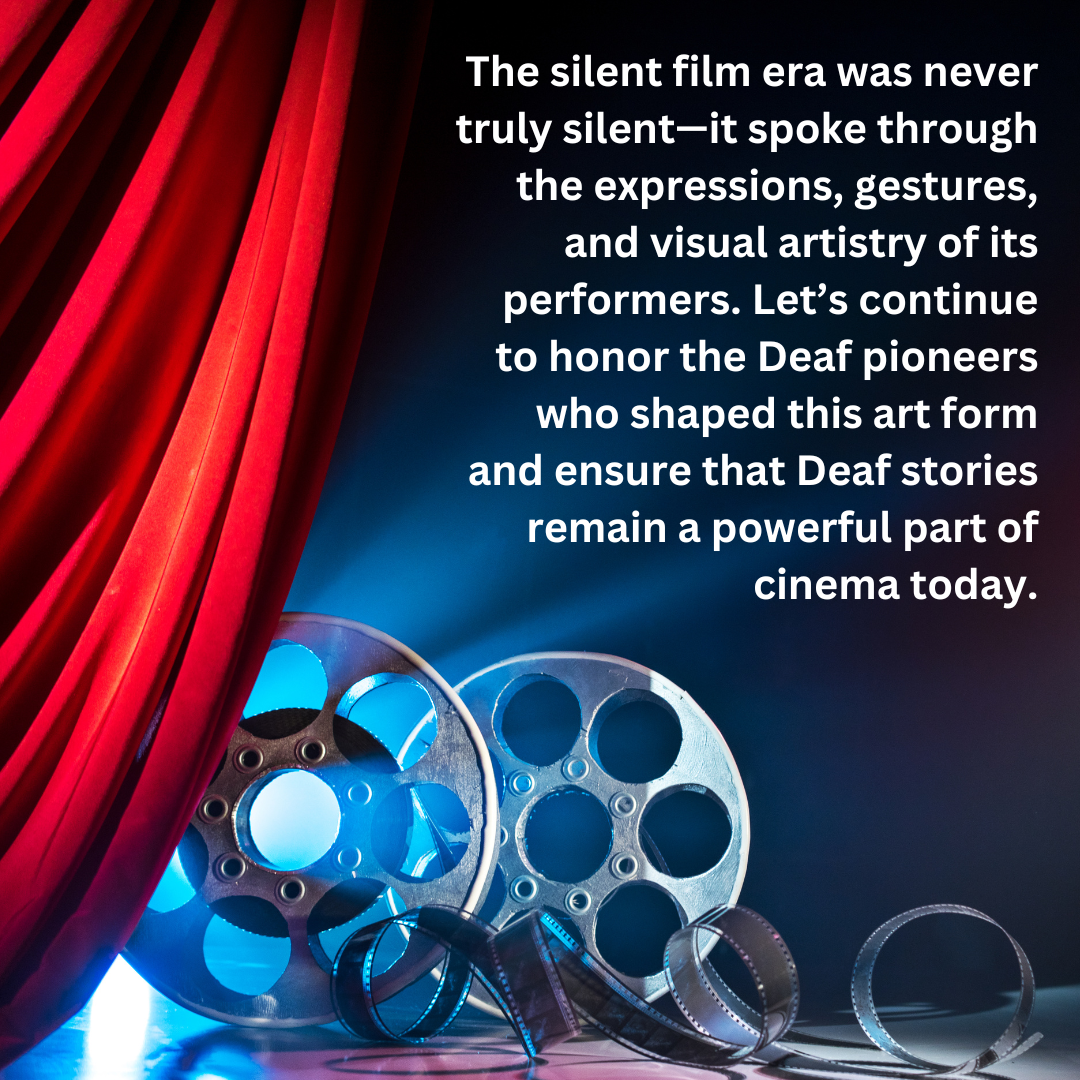Day 19. The Hidden Heroes of Silent Films.

Honoring Deaf Actors and Creators in Hollywood’s Silent Era
“Silent film is not silent. It speaks volumes—without a single spoken word.”
Before the era of talkies, Hollywood’s silent films relied entirely on visual storytelling—making them uniquely accessible to Deaf audiences and performers alike. While mainstream film history often highlights stars like Charlie Chaplin and Buster Keaton, Deaf actors, directors, and creatives played a pivotal role in shaping the industry. Their contributions remain largely forgotten, but today, we shine a light on these hidden heroes of silent cinema.
The Silent Film Era: A Natural Space for Deaf Artists
In the late 19th and early 20th centuries, silent films dominated entertainment. With no synchronized dialogue, the art of expression, gesture, and body language became the primary means of storytelling.
For Deaf actors, this was an opportunity to thrive. They already had a natural fluency in expressive communication—skills that were highly valued in silent cinema. Many Deaf performers and filmmakers contributed to this golden age, though their names have been largely erased from history.
Deaf Pioneers in Silent Cinema
Granville Redmond: Actor and Visual Artist
Granville Redmond (1871–1935) was a Deaf actor, painter, and close friend of Charlie Chaplin. Born Deaf due to scarlet fever, Redmond attended the California School for the Deaf, where he developed his talent in both acting and art.
Chaplin recognized Redmond’s extraordinary ability to convey deep emotions without words. He cast him in multiple films, including “City Lights” (1931), where Redmond’s expressive face and movements captivated audiences. While Chaplin is often credited for pioneering silent film’s physical comedy, many believe Redmond influenced Chaplin’s iconic style.
🖼️ Fun Fact: Redmond was also a celebrated landscape painter, and his works still hang in museums today!
Gilbert Eastman: Actor and Filmmaker
Though he gained prominence later in the mid-20th century, Gilbert Eastman (1934–2006) was heavily inspired by the visual storytelling of silent films. He studied at Gallaudet University and later became a pioneer of Deaf filmmaking and theater.
He was one of the first Deaf filmmakers to advocate for sign language on screen, drawing from the techniques of early silent actors. Eastman’s contributions helped shape the modern Deaf film movement, keeping the silent film tradition alive in Deaf storytelling.
The Uncredited Deaf Extras of Silent Hollywood
Beyond the well-documented Deaf performers, many Deaf actors worked as extras in silent films. Since movies at the time didn’t require spoken dialogue, Deaf individuals found work in:
🔹 Vaudeville-style slapstick comedy
🔹 Mimicry performances (a skill highly valued in early film)
🔹 Background acting in crowd scenes
Unfortunately, most were uncredited, and little documentation exists of their contributions. However, their presence was vital to the industry, influencing theatrical techniques still used in film today.
How Hollywood’s “Talkies” Pushed Deaf Actors Out
The advent of “talkies” (films with synchronized sound) in the late 1920s changed the industry forever.
🔹 Actors now needed to speak clearly on camera
🔹 Filmmakers prioritized voice performance over physical storytelling
🔹 Deaf performers were largely excluded
As the industry shifted, Deaf representation in Hollywood dwindled, and many of the Deaf pioneers of silent film were forgotten. However, their legacy did not disappear. Today, Deaf filmmakers, actors, and artists are reclaiming space in the film industry, honoring the visual storytelling traditions that silent cinema perfected.
The Legacy of Deaf Storytelling in Film Today
🎬 Deaf-Led Cinema: Films like CODA (2021) and The Silent Child (2017) show a resurgence of Deaf stories on screen.
🎭 Visual Theater: Deaf performers continue to incorporate silent film techniques in stage and film productions.
💬 ASL Storytelling: Modern Deaf filmmakers use American Sign Language (ASL) as a cinematic language, much like silent film once did.
Silent film was an era of opportunity for Deaf performers, and their influence can still be seen in visual storytelling today.
Resources & Further Reading
📚 Articles & Books
📖 Hollywood’s Forgotten Deaf Stars
📖 Silent Film and the Deaf Experience
📽️ Films & Documentaries
▶️ City Lights (1931) – Featuring Granville Redmond.
▶️ Deaf Cinema Then & Now – A short documentary on Deaf actors in silent films.
Reflection
The silent film era was never truly silent—it spoke through the expressions, gestures, and visual artistry of its performers. Let’s continue to honor the Deaf pioneers who shaped this art form and ensure that Deaf stories remain a powerful part of cinema today.
💬 What are your favorite silent films?
💬Did you know about Deaf contributions to early Hollywood? What can you do in your community to honor the contributions of Deaf actors in silent films?
Tomorrow, we’ll highlight the contributions of Rev. Thomas Gallaudet, a leader in religion and Deaf inclusion.
Learn more: 🎬 Watch Granville Redmond in Silent Film: City Lights (1931).
#UU #UUA #CelebrateDiversity #DeafCulture #DeafHistoryMonth #DisabilityAwareness #SilentFilm #DeafHollywood #SignLanguageOnScreen
Discover more from SepulvedaUU
Subscribe to get the latest posts sent to your email.
